How to ask a question in Spanish
Structure
In these videos we will learn how to ask questions in Spanish and the correct order.
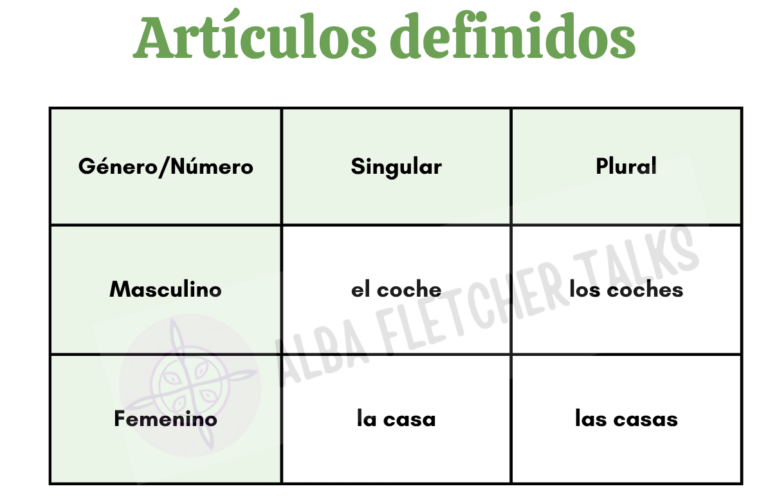
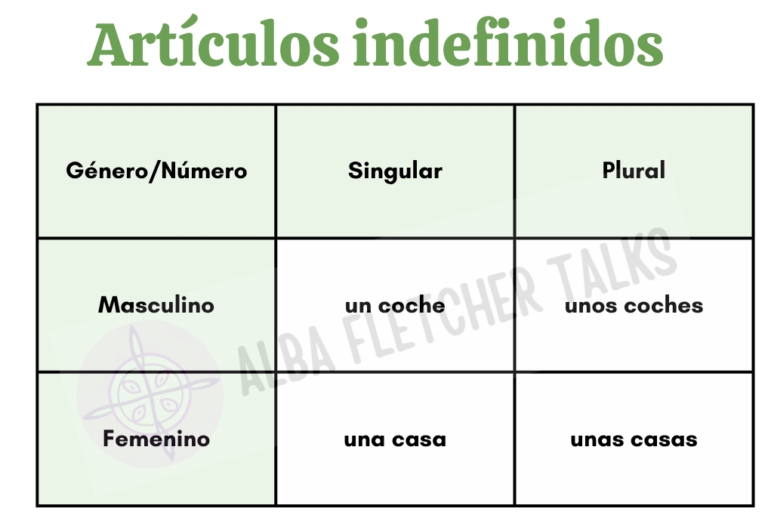
Artículos definidos y
artículos indefinidos
Exercises
Completa los artículos definido o indefinido.
Complete the definite or indefinite.
INTENTA TRADUCIR cada frase antes de completar para aprender al mismo tiempo vocabulario y estructura.
TRY TO TRANSLATE each sentence before completing it to learn vocabulary and structure at the same time.
___ casa de mi abuela es muy grande.
Me gustan ___ películas de Brad Pitt.
Tengo ___ amigo que vive en España.
___ coches rojos son mis favoritos.
Dame ___ manzana, por favor.
___ hijos de María están jugando al fútbol.
Compré ___ libros en la librería.
¿Puedes darme ___ bolígrafo?
No encuentro ___ mochila.
Siempre veo a ___ hombre muy amable en el supermercado.
Traducciones
My grandmother’s house is very big.
I like Brad Pitt’s movies.
I have a friend who lives in Spain.
Red cars are my favorites.
Give me an apple, please.
María’s children are playing football.
I bought some books at the bookstore.
Can you give me a pen?
I can’t find the backpack.
I always see a very kind man in the supermarket.
Respuestas
1. la, 2. las, 3. un, 4. los, 5. una, 6. los, 7. unos, 8. un, 9. la, 10. un
Completa los artículos definidos, indefinido, o sin nada.
Complete the definite, indefinite, or no article.
___ gente está esperando en la estación.
Me gusta leer ___ libros de aventura.
___ sol brilla muy fuerte hoy.
Vamos a comprar ___ pan fresco.
___ perros de mi vecino siempre ladran.
Me gusta beber___ agua.
Siempre estudio en ___ biblioteca de la universidad.
Me gustaría ir a ___ playa este fin de semana.
___ niños no estaban en clase.
Siempre compro___ fruta en el comercio local.
Traducciones
__ people are waiting at the station.
I like to read ___ adventure books.
___ sun is shining very brightly today.
We are going to buy ___ fresh bread.
___ dogs of my neighbor are always barking.
I like drinking ___ water.
I always study in ___ university library.
I would like to go to ___ beach this weekend.
___ children were not in class.
I see ___ man selling flowers on the street.
Respuestas
1) La 2)__ 3) El 4)___ 5) Los 6)__ 7) la 8) la 9) Los 10)___
1. Gente siempre lleva artículo en español a diferencia de inglés. La gente está loca. Me gusta la gente alegre.
2: Es algo en general, no libros en concreto.
4. Es incontable. Cuando es incontable no ponemos artículo. I like bread. Es diferente si es uno en concreto. Me gusta el pan de esta tienda. I like the bread from this shop.
5. Es en general, no un agua en concreto. I like to drink water.
Es diferente si es uno en concreto. Me gusta más el agua cuando está fría.
10. Es incontable. I always buy fruit. It’s different if it is the subject. La fruta no me gusta.
*When it is the subject of the phrases, it will always have an article. La fruta es buena para la salud. La gente es amable aquí. La policía está cerca.
Ahora haz tus propias frases, frases que sean útiles para tu día a día. Puedes tomar estos ejemplos y adaptarlos.
Now make your own sentences, sentences that are useful for your day-to-day life. You can take these examples and adapt them.
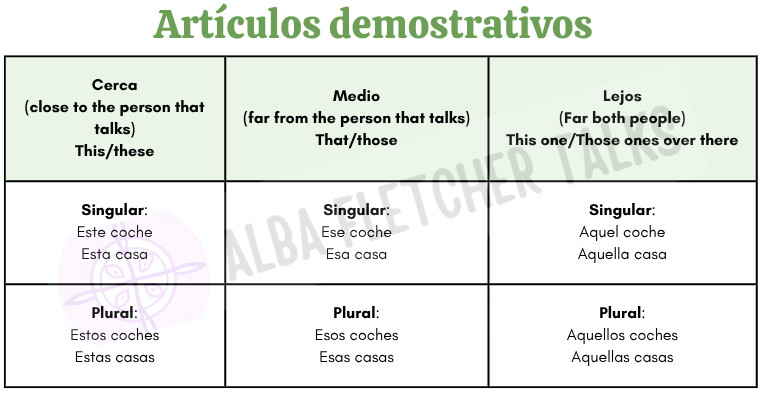
Este coche es muy rápido. This car is very fast
Ese coche es muy caro. That car is very expensive.
Aquellos coches son algo viejos. Those cars over there are a little bit old.
La diferencia entre ese y aquel, es que cuando una persona utiliza ese, indica que está lejos de él/ella, pero cerca de la persona a la que le habla.
Cuando utiliza aquel, indica que está lejos de él y de la persona que habla.
Pero lo más importante es entender que este es cerca, y ese y aquel es más lejos.
The difference between «ese» and «aquel» is that when a person uses «ese,» it indicates that it is far from him/here, but close to the person they are speaking to.
When they use «aquel,» it indicates that it is far from both the speaker and the person they are speaking to.
But the most important thing is to understand that «este» is close, and «ese» and «aquel» are farther away.
Artículos demostrativos
Exercises
Completa con el correcto artículo demostrativo.
Complete with the right «demostrativo» article.
_______ libro es muy interesante. (Cerca)
_______ zapatos que llevas son muy bonitos. (Cerca)
_______ chica de allá es mi amiga. (Lejos)
¿Vas a comprar _______ coche rojo o _______ azul? (Cerca, Lejos)
_______ casa de la esquina está en venta. (Medio)
_______ película que vimos anoche me gustó mucho. (Medio)
_______ niños están jugando en el parque. (Lejos)
Prefiero _______ pizza que comimos ayer. (Cerca)
¿Has visto _______ película de terror? (Medio)
Me gusta _______ paisaje que veo desde aquí. (Cerca)
Traducciones
_______ book is very interesting. (Close)
_______ shoes you’re wearing are very nice. (Close)
_______ girl over there is my friend. (Far)
Are you going to buy _______ red car or _______ blue one? (Close, Far)
_______ house on the corner is for sale. (Medium distance)
_______ movie we watched last night was really good. (Medium distance)
_______ kids are playing in the park. (Far)
I prefer _______ pizza we ate yesterday. (Close)
Have you seen _______ horror movie? (Medium distance)
I like _______ view I see from here. (Close)
Respuestas
1. Este, 2. Esos, 3. Aquella, 4. Este, Aquel, 5. Esa, 6. Esa, 7. Aquellos, 8. Esta, 9. Esa, 10. Este.
Ahora haz tus propias frases, frases que sean útiles para tu día a día. Puedes tomar estos ejemplos y adaptarlos.
Now make your own sentences, sentences that are useful for your day-to-day life. You can take these examples and adapt them.
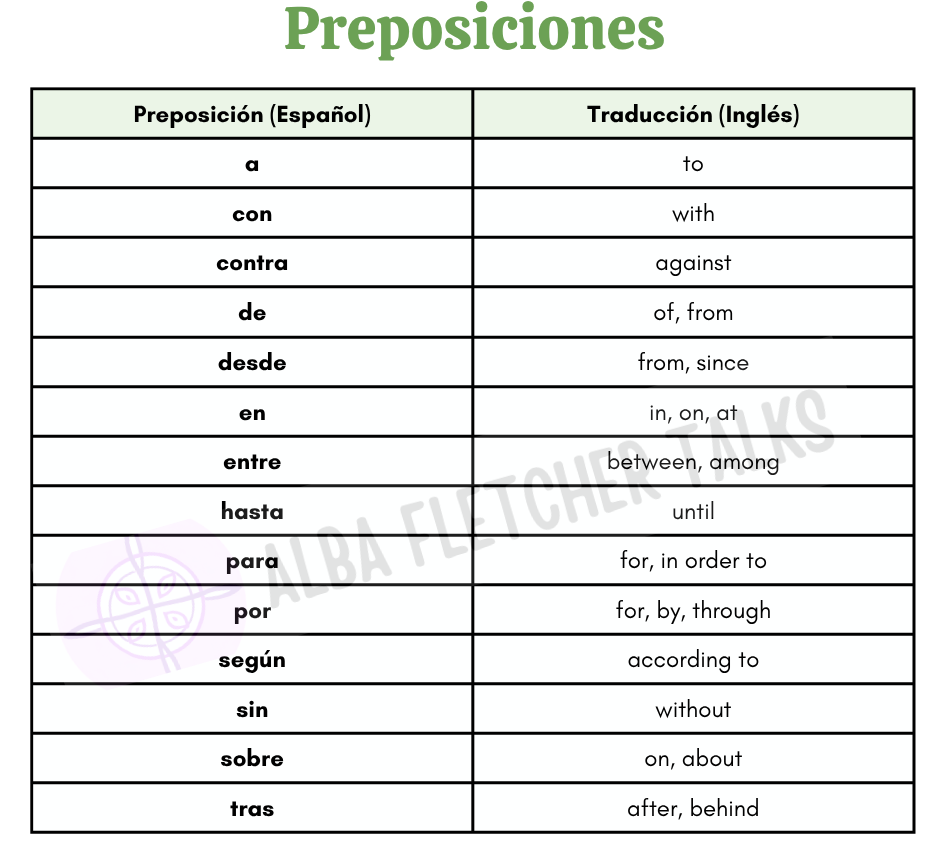
Voy a la tienda. – I go to the store.
Estudio con mis amigos. – I study with my friends.
Soy de España – I am from Spain.
El libro es de Juan. – The book is Juan’s. (of Juan)
Trabajo desde mi casa. – I work from my home.
El gato está en la casa. – The cat is in the house.
Hay mucha gente entre las mesas. – There are many people between the tables.
Como hasta las tres de la tarde. – I eat until three in the afternoon.
Este regalo es para ti. – This gift is for you.
Camino por el parque. – I walk through the park.
Según el profesor, hoy no hay clase. – According to the teacher, there is no class today.
Vivo sin preocupaciones. – I live without worries.
Hablo sobre mis planes. – I talk about my plans.
El perro corre tras la pelota. – The dog runs after the ball.
Preposiciones
Exercises
Completa con la preposición correcta.
Complete with the right preposition.
El gato está _______ la casa.
Como _______ las tres de la tarde.
Trabajo _______ mi casa los viernes.
Voy _______ la tienda a comprar pan.
Hay muchas personas _______ las mesas.
Estudio _______ mis amigos todos los días.
Vivo cerca _______ la playa.
Este regalo es _______ ti.
El libro es _______ Juan.
Camino _______ el parque todas las mañanas.
_______ el profesor, la clase empieza a las 10.
Vivo _______ preocupaciones.
El perro corre _______ la pelota en el jardín.
Hablo _______ mis planes con mis amigos.
Traducciones
The cat is in the house.
I eat until three in the afternoon.
I work from my home on Fridays.
I go to the store to buy bread.
There are many people between the tables.
I study with my friends every day.
I live near the beach.
This gift is for you.
The book is Juan’s.
I walk through the park every morning.
According to the teacher, the class starts at 10.
I live without worries.
The dog runs after the ball in the garden.
I talk about my plans with my friends.
Respuestas
1: en 2: hasta 3: desde 4: a 5: entre 6: con 7: de 8: para 9: de 10: por 11: Según 12: sin 13: tras 14: sobre
Ahora haz tus propias frases, frases que sean útiles para tu día a día. Puedes tomar estos ejemplos y adaptarlos.
Now make your own sentences, sentences that are useful for your day-to-day life. You can take these examples and adapt them.
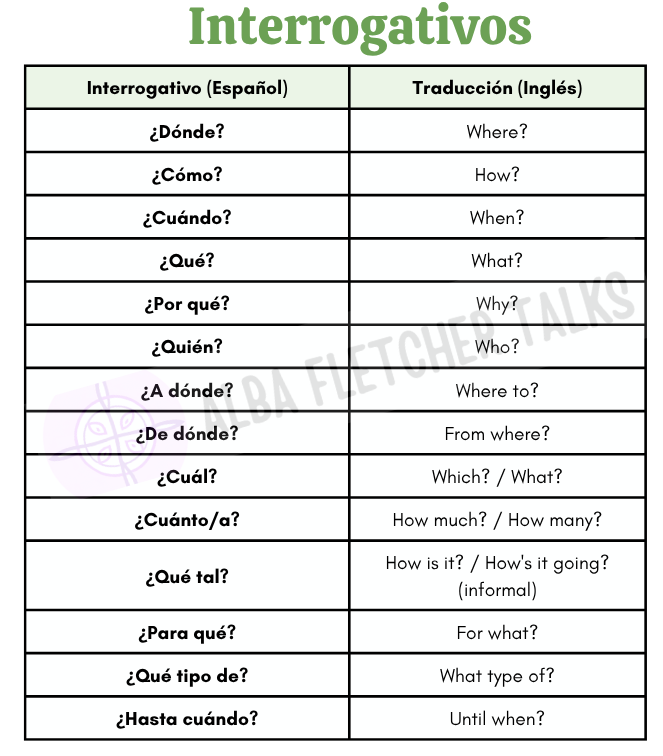
¿Dónde vives? (Where do you live?)
¿Cómo estás? (How are you?)
¿Cuándo comes? (When do you eat?)
¿Qué haces? (What do you do?)
¿Por qué estudias español? (Why do you study Spanish?)
¿Quién te llama? (Who is calling you?)
¿A dónde vas? (Where are you going (to)?)
¿De dónde eres? (Where are you from?)
¿Cuál prefieres? (Which one do you prefer?)
¿Cuánto cuesta? (How much does it cost?)
¿Qué tal tu día? (How’s your day?)
¿Para qué estudias? (What do you study for?)
¿Qué tipo de comida te gusta? (What type of food do you like?)
¿Hasta cuándo trabajas? (Until when do you work?)
Como puedes ver, la preposición que normalmente en inglés va al final «Where are you from«? «What are you here for» «Where are you going (to)?»
en español van al principio. «¿De dónde eres? «¿Para qué estás aquí?» «¿A dónde vas?»
As you can see, the preposition that normally goes at the end in English, like in ‘Where are you from?’, ‘What are you here for?’, ‘Where are you going (to)?’, in Spanish goes at the beginning: ‘¿De dónde eres?’, ‘¿Para qué estás aquí?’, ‘¿A dónde vas?’
Interrogativos
Exercises
Completa con la preposición correcta.
Complete with the right preposition.
_______ vives en la ciudad?
_______ estás tan cansado hoy?
_______ vamos a salir esta tarde?
_______ te llamas?
_______ te gusta hacer en tu tiempo libre?
_______ es tu color favorito?
_______ es tan bonito este lugar?
_______ vas?
_______ tienes ahí?
_______ amigos tienes?
_______ la película?
_______ estudias español?
_______ de comida prefieres?
_______ estás en la ciudad?
Traducciones
- Where do you live in the city?
- Why are you so tired today?
- When are we going to go out this afternoon?
- What’s your name?
- What do you like to do in your free time?
- What is your favorite color?
- Why is this place so beautiful?
- Where are you going?
- What do you have there?
- How many friends do you have?
- How’s movie?
- Why are you studying Spanish?
- What type of food do you prefer?
- Until when are you in the city?
Respuestas
1. ¿Dónde? 2. ¿Por qué? 3. ¿Cuándo? 4. ¿Cómo? 5. ¿Qué? 6. ¿Cuál? 7. ¿Por qué? 8. ¿A dónde? 9. ¿Qué? 10. ¿Cuántos? 11. ¿Qué tal? 12. ¿Por qué? 13. ¿Qué tipo? 14. ¿Hasta cuándo?
Ahora haz tus propias frases, frases que sean útiles para tu día a día. Puedes tomar estos ejemplos y adaptarlos.
Now make your own sentences, sentences that are useful for your day-to-day life. You can take these examples and adapt them.
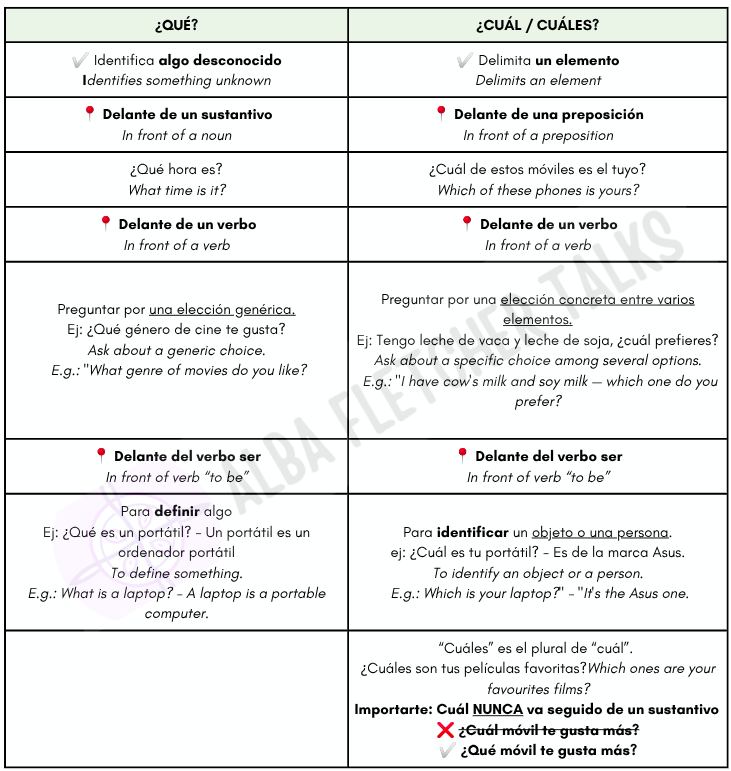
Diferencia entre "qué" o "cuál"
Exercises
Completa con «qué», «cuál» o «cuáles»
Complete with «qué», «cuál» o «cuáles»
_________ es la capital de México?
¿___________ es el tequila?
_________ son las lenguas oficiales de Belice?
¿___________ son los monumentos más importantes de Colombia?
¿___________ es tu ordenador?
Tengo té negro y verde. ¿_________ prefieres?
¿___________ día es hoy ?
¿___________ de estos platos prefieres?
Traducciones
_________ is the capital of Mexico?
_________ is tequila?
_________ are the official languages of Belize?
_________ are the most important monuments in Colombia?
_________ is your computer?
I have black tea and green tea. _________ do you prefer?
_________ is your favorite actor?
_________ of these dishes do you prefer?
Respuestas
1. Cuál 2. Qué 3. Cuáles 4. Cuáles 5. Cuál 6. Cuál 7. Qué 8. Cuál
Answer the questions to revise everything
¿Para qué necesitas este número de teléfono?
Lo necesito para reservar una cita con el médico. Estoy algo enfermo, y este es el médico con mejores opiniones en el centro médico.
¿De dónde es este libro?
Es de la biblioteca. Es un libro que habla sobre la vida de un famoso cantante, y cuenta toda su vida. Es muy interesante la verdad.
¿Cuál de estas películas prefieres ver?
Pues creo que la película británica, porque tiene muy buenos actores y me gusta mucho el director. Además tiene muy buenas opiniones.
¿Cuánto cuesta esta camiseta?
Esta camiseta cuesta 15 euros. Pero tiene allí otra camiseta en un color diferente que tiene un descuento del 15%.
¿Hasta cuándo vas a quedarte en Madrid?
Depende del cliente. Tenemos varios asuntos que tratar. Según mi jefe, en dos días podemos cerrar todos los asuntos pendiente, pero no estoy seguro. Te aviso mañana.
Haz tus propias preguntas y frases e intenta que sean reales.
Piensa en todas las preguntas que haces día a día, y escríbelas en español.
Make your own questions and sentences and try to make them realistic. Think about all the questions you ask every day, and write them in Spanish.
